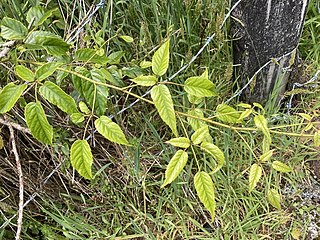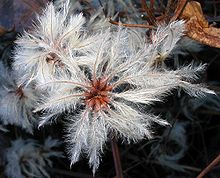
A vine is any plant with a growth habit of trailing or scandent stems, lianas, or runners. The word vine can also refer to such stems or runners themselves, for instance, when used in wicker work.

Clematis is a genus of about 380 species within the buttercup family, Ranunculaceae. Their garden hybrids and cultivars have been popular among gardeners, beginning with Clematis 'Jackmanii', a garden staple since 1862; more cultivars are being produced constantly. They are mainly of Chinese and Japanese origin.

Passiflora edulis, commonly known as passion fruit, is a vine species of passion flower native to southern Brazil and Peru. It is cultivated commercially in tropical and subtropical areas for its sweet, seedy fruit. The fruit is a pepo, a type of berry, round to oval, either yellow or dark purple at maturity, with a soft to firm, juicy interior filled with numerous seeds. The fruit is both eaten and juiced, with the juice often added to other fruit juices to enhance aroma.

Clematis flammula, the fragrant virgin's bower, is a species of flowering plant in the family Ranunculaceae. This deciduous climbing plant is native to southern Europe and northern Africa, but it is cultivated worldwide as an ornamental plant in gardens. It bears fragrant white flowers and small green achenes. When the flowers are newly opened they have a strong sweet almond fragrance. Clematis × aromatica, the scented clematis, is the result of a cross with Clematis integrifolia.

Cornus sanguinea, the common dogwood or bloody dogwood, is a species of dogwood native to most of Europe and western Asia, from England and central Scotland east to the Caspian Sea. It is widely grown as an ornamental plant.

Cleeve Wood, Hanham is a is an 8.9 hectare biological Site of Special Scientific Interest (SSSI) in South Gloucestershire, notified in 1966.

Ipomoea indica is a species of flowering plant in the family Convolvulaceae, known by several common names, including blue morning glory, oceanblue morning glory, koali awa, and blue dawn flower. It bears heart-shaped or three-lobed leaves and purple or blue funnel-shaped flowers 6–8 cm (2–3 in) in diameter, from spring to autumn. The flowers produced by the plant are hermaphroditic. This plant has gained the Royal Horticultural Society's Award of Garden Merit.

Clematis ligusticifolia is a climbing, spreading vine with showy flowers. It is also known as old-man's beard, yerba de chiva, and virgin's bower,. It is native to North America where it is widespread across the western United States in streamside thickets, wooded hillsides, and coniferous forests up to 8,500 feet (2,600 m).
This page provides a glossary of plant morphology. Botanists and other biologists who study plant morphology use a number of different terms to classify and identify plant organs and parts that can be observed using no more than a handheld magnifying lens. This page provides help in understanding the numerous other pages describing plants by their various taxa. The accompanying page—Plant morphology—provides an overview of the science of the external form of plants. There is also an alphabetical list: Glossary of botanical terms. In contrast, this page deals with botanical terms in a systematic manner, with some illustrations, and organized by plant anatomy and function in plant physiology.

Clematis terniflora is a plant in the buttercup family, Ranunculaceae. It is native to northeastern Asia. It was introduced into the United States in the late 1800s as an ornamental garden plant, and has naturalized in many of the eastern states. It is considered a Category II invasive plant in north and central Florida and some other eastern states, meaning it is invading native plant communities but has not yet seen as displacing native species.
This glossary of botanical terms is a list of definitions of terms and concepts relevant to botany and plants in general. Terms of plant morphology are included here as well as at the more specific Glossary of plant morphology and Glossary of leaf morphology. For other related terms, see Glossary of phytopathology, Glossary of lichen terms, and List of Latin and Greek words commonly used in systematic names.

Leucopogon parviflorus, commonly known as coast beard-heath or native currant, is a shrub or small tree in the family Ericaceae. It is native to all Australian states and territories excluding the Northern Territory and the ACT and also grows in New Zealand. The species can grow to between 1 and 5 metres in height and has leaves that are 11 to 29 mm long and 2.4 to 7.5 mm in width, often with curved tips. The white flowers are around 15 mm long and are produced in spikes of 7 to 13. These occur throughout the year.

Clematis aristata, known as Australian clematis, wild clematis, goat's beard or old man's beard, is a climbing shrub of the family Ranunculaceae, found in eastern Australia in dry and wet forests of Queensland, New South Wales, Victoria and Tasmania. In spring to early summer it produces mass displays of attractive star-shaped flowers usually borne in short panicles with each flower up to 70 mm diameter and possessing four narrow white or cream tepals. Fertile male and female reproductive structures occur in flowers of separate plants (dioecy) making this species an obligate outcrosser with pollen movement among plants most likely facilitated by insects. Each seed head on female plants consists of multiple achenes with each seed bearing a plumose awn 2–4.5 cm long promoting dispersal by wind.

Rubus cissoides, commonly called bush lawyer or tātarāmoa in te reo Māori, is a species of flowering plant in the family Rosaceae, endemic to New Zealand. Alan Cunningham described R. cissoides in 1839. Plants of this species of are perennial scrambling vines with compound leaves with 3-5 leaflets each up to 15 cm long, reddish prickles on the branches, white flowers from September to November and red berries from December to April. The conservation status of R. cissoides is Not Threatened, it is widespread on all three main islands of mainland New Zealand, and it has been used by Māori as food, medicines and construction materials.

Old man's beard is an invasive plant in New Zealand that affects indigenous biodiversity. It is declared an unwanted organism under the Biosecurity Act 1993 which means it cannot be sold, distributed or propagated.

Gardening is a popular pastime in New Zealand. A 2007/2008 survey of physical activities found that 43% of New Zealanders had participated in gardening in the previous 12 months. A range of books, magazines and television programmes are dedicated to the topic.

Clematis paniculata is a species of flowering plant in the buttercup family Ranunculaceae. It is one of seven species of clematis native to New Zealand. C. paniculata is the most common of these, and is widespread in forests throughout the country.
Calophoma clematidina is a fungal plant pathogen and the most common cause of the disease clematis wilt affecting large-flowered varieties of Clematis. Symptoms of infection include leaf spotting, wilting of leaves, stems or the whole plant and internal blackening of the stem, often at soil level. Infected plants growing in containers may also develop root rot.

Clematis orientalis is a deciduous vine or scrambling shrub in the buttercup family Ranunculaceae, that originates from Asia and Central Europe. It was brought to the United States as an ornamental plant but escaped cultivation leading to its classification as a noxious weed in some states. Common names for C. orientalis include Chinese clematis, Oriental virginsbower, orange peel, and orange peel clematis.

Clematis gouriana, or Indian Traveller's Joy, is a liana found in Asia which belongs to the buttercup family (Ranunculaceae). It was described by Roxb. ex DC. and published in Regni Vegetabilis Systema Naturale 1: 138-139, in 1818.






















